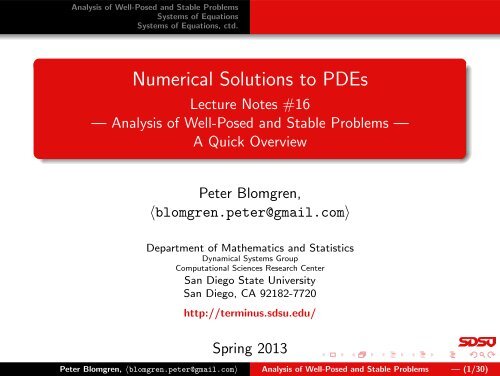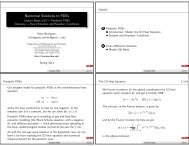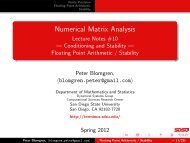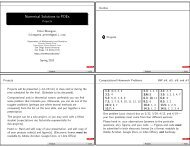Analysis of Well-Posed and Stable Problems - Peter Blomgren - SDSU
Analysis of Well-Posed and Stable Problems - Peter Blomgren - SDSU
Analysis of Well-Posed and Stable Problems - Peter Blomgren - SDSU
You also want an ePaper? Increase the reach of your titles
YUMPU automatically turns print PDFs into web optimized ePapers that Google loves.
<strong>Analysis</strong> <strong>of</strong> <strong>Well</strong>-<strong>Posed</strong> <strong>and</strong> <strong>Stable</strong> <strong>Problems</strong><br />
Systems <strong>of</strong> Equations<br />
Systems <strong>of</strong> Equations, ctd.<br />
Numerical Solutions to PDEs<br />
Lecture Notes #16<br />
— <strong>Analysis</strong> <strong>of</strong> <strong>Well</strong>-<strong>Posed</strong> <strong>and</strong> <strong>Stable</strong> <strong>Problems</strong> —<br />
A Quick Overview<br />
<strong>Peter</strong> <strong>Blomgren</strong>,<br />
〈blomgren.peter@gmail.com〉<br />
Department <strong>of</strong> Mathematics <strong>and</strong> Statistics<br />
Dynamical Systems Group<br />
Computational Sciences Research Center<br />
San Diego State University<br />
San Diego, CA 92182-7720<br />
http://terminus.sdsu.edu/<br />
Spring 2013<br />
<strong>Peter</strong> <strong>Blomgren</strong>, 〈blomgren.peter@gmail.com〉 <strong>Analysis</strong> <strong>of</strong> <strong>Well</strong>-<strong>Posed</strong> <strong>and</strong> <strong>Stable</strong> <strong>Problems</strong> — (1/30)
Outline<br />
<strong>Analysis</strong> <strong>of</strong> <strong>Well</strong>-<strong>Posed</strong> <strong>and</strong> <strong>Stable</strong> <strong>Problems</strong><br />
Systems <strong>of</strong> Equations<br />
Systems <strong>of</strong> Equations, ctd.<br />
1 <strong>Analysis</strong> <strong>of</strong> <strong>Well</strong>-<strong>Posed</strong> <strong>and</strong> <strong>Stable</strong> <strong>Problems</strong><br />
Introduction: <strong>Well</strong>-<strong>Posed</strong> IVPs<br />
First Order (Time) PDEs<br />
Higher Order (Time) Equations<br />
2 Systems <strong>of</strong> Equations<br />
<strong>Well</strong>-<strong>Posed</strong>ness for First Order Systems<br />
General Definitions: Parabolic & Hyperbolic Systems<br />
Lower Order Terms<br />
3 Systems <strong>of</strong> Equations, ctd.<br />
Inhomogeneous <strong>Problems</strong><br />
The Kreiss Matrix Theorem<br />
<strong>Peter</strong> <strong>Blomgren</strong>, 〈blomgren.peter@gmail.com〉 <strong>Analysis</strong> <strong>of</strong> <strong>Well</strong>-<strong>Posed</strong> <strong>and</strong> <strong>Stable</strong> <strong>Problems</strong> — (2/30)
Introduction<br />
<strong>Analysis</strong> <strong>of</strong> <strong>Well</strong>-<strong>Posed</strong> <strong>and</strong> <strong>Stable</strong> <strong>Problems</strong><br />
Systems <strong>of</strong> Equations<br />
Systems <strong>of</strong> Equations, ctd.<br />
Introduction: <strong>Well</strong>-<strong>Posed</strong> IVPs<br />
First Order (Time) PDEs<br />
Higher Order (Time) Equations<br />
In the next ≈3 lectures we will cover the high-lights <strong>of</strong> chapters<br />
9–11: “<strong>Analysis</strong> <strong>of</strong> <strong>Well</strong>-<strong>Posed</strong> <strong>and</strong> <strong>Stable</strong> <strong>Problems</strong>”,<br />
“Convergence Estimates for Initial Value <strong>Problems</strong>”, <strong>and</strong><br />
“<strong>Well</strong>-<strong>Posed</strong> <strong>and</strong> <strong>Stable</strong> Initial-Boundary Value <strong>Problems</strong>.”<br />
The purpose is to showcase some <strong>of</strong> the theoretical results <strong>and</strong><br />
tools which may be useful to a computational scientist, without<br />
delving into all the finer details <strong>of</strong> every pro<strong>of</strong>...<br />
We start out with well-posedness, a key concept in scientific<br />
modeling <strong>and</strong> the underst<strong>and</strong>ing <strong>of</strong> finite difference schemes used<br />
in computations.<br />
Many <strong>of</strong> the ideas go back to Jacques S. Hadamard (1865–1963),<br />
<strong>and</strong> make plenty use <strong>of</strong> Fourier (von Neumann) analysis. The<br />
culmination <strong>of</strong> our discussion <strong>of</strong> well-posedness is the statement <strong>of</strong><br />
the Kreiss matrix theorem.<br />
<strong>Peter</strong> <strong>Blomgren</strong>, 〈blomgren.peter@gmail.com〉 <strong>Analysis</strong> <strong>of</strong> <strong>Well</strong>-<strong>Posed</strong> <strong>and</strong> <strong>Stable</strong> <strong>Problems</strong> — (3/30)
<strong>Analysis</strong> <strong>of</strong> <strong>Well</strong>-<strong>Posed</strong> <strong>and</strong> <strong>Stable</strong> <strong>Problems</strong><br />
Systems <strong>of</strong> Equations<br />
Systems <strong>of</strong> Equations, ctd.<br />
<strong>Well</strong>-<strong>Posed</strong> Initial Value <strong>Problems</strong><br />
Some equations, e.g.<br />
Introduction: <strong>Well</strong>-<strong>Posed</strong> IVPs<br />
First Order (Time) PDEs<br />
Higher Order (Time) Equations<br />
Wave Eqn.: utt −a 2 uxx = 0, Heat Eqn.: ut = buxx,<br />
<strong>and</strong> variants there<strong>of</strong>, arise frequently in applied mathematics, but other<br />
equations, such as<br />
utt = ux,<br />
do not show up as governing equations <strong>of</strong> physical systems. It is natural<br />
to ask why?!<br />
<strong>Peter</strong> <strong>Blomgren</strong>, 〈blomgren.peter@gmail.com〉 <strong>Analysis</strong> <strong>of</strong> <strong>Well</strong>-<strong>Posed</strong> <strong>and</strong> <strong>Stable</strong> <strong>Problems</strong> — (4/30)
<strong>Analysis</strong> <strong>of</strong> <strong>Well</strong>-<strong>Posed</strong> <strong>and</strong> <strong>Stable</strong> <strong>Problems</strong><br />
Systems <strong>of</strong> Equations<br />
Systems <strong>of</strong> Equations, ctd.<br />
<strong>Well</strong>-<strong>Posed</strong> Initial Value <strong>Problems</strong><br />
Some equations, e.g.<br />
Introduction: <strong>Well</strong>-<strong>Posed</strong> IVPs<br />
First Order (Time) PDEs<br />
Higher Order (Time) Equations<br />
Wave Eqn.: utt −a 2 uxx = 0, Heat Eqn.: ut = buxx,<br />
<strong>and</strong> variants there<strong>of</strong>, arise frequently in applied mathematics, but other<br />
equations, such as<br />
utt = ux,<br />
do not show up as governing equations <strong>of</strong> physical systems. It is natural<br />
to ask why?!<br />
In order to be a useful model <strong>of</strong> a well-behaved physical process, a PDE<br />
must have several properties, one <strong>of</strong> which is that the solution should<br />
depend on initial (boundary) data in a continuous way, so that small<br />
errors due to physical experimentation <strong>and</strong> numerical representation do<br />
not overwhelm the solution; here the definition <strong>of</strong> “small” must be<br />
reasonable (uxxx ≤ ǫ is usually not...)<br />
<strong>Peter</strong> <strong>Blomgren</strong>, 〈blomgren.peter@gmail.com〉 <strong>Analysis</strong> <strong>of</strong> <strong>Well</strong>-<strong>Posed</strong> <strong>and</strong> <strong>Stable</strong> <strong>Problems</strong> — (4/30)
<strong>Analysis</strong> <strong>of</strong> <strong>Well</strong>-<strong>Posed</strong> <strong>and</strong> <strong>Stable</strong> <strong>Problems</strong><br />
Systems <strong>of</strong> Equations<br />
Systems <strong>of</strong> Equations, ctd.<br />
The Continuity Condition<br />
Introduction: <strong>Well</strong>-<strong>Posed</strong> IVPs<br />
First Order (Time) PDEs<br />
Higher Order (Time) Equations<br />
Here we are concerned with linear problems (the story for<br />
non-linear problems is quite different), the continuity condition is<br />
satisfied if the solution to the PDE satisfy<br />
u(t,◦) ≤ CTu(0,◦), t ≤ T,<br />
measured in some norm, i.e. L 1 , L 2 , L 4 , or L ∞ , where CT is a<br />
constant independent <strong>of</strong> the solution.<br />
If we have two solutions v(t,x), <strong>and</strong> w(t,x), then by the linearity<br />
v(t,◦)−w(t,◦) ≤ CTv(0,◦)−w(0,◦),<br />
which shows that small changes in initial data results in small<br />
(bounded by a multiplicative constant) changes in the solution at<br />
time t ≤ T.<br />
<strong>Peter</strong> <strong>Blomgren</strong>, 〈blomgren.peter@gmail.com〉 <strong>Analysis</strong> <strong>of</strong> <strong>Well</strong>-<strong>Posed</strong> <strong>and</strong> <strong>Stable</strong> <strong>Problems</strong> — (5/30)
<strong>Analysis</strong> <strong>of</strong> <strong>Well</strong>-<strong>Posed</strong> <strong>and</strong> <strong>Stable</strong> <strong>Problems</strong><br />
Systems <strong>of</strong> Equations<br />
Systems <strong>of</strong> Equations, ctd.<br />
Introduction: <strong>Well</strong>-<strong>Posed</strong> IVPs<br />
First Order (Time) PDEs<br />
Higher Order (Time) Equations<br />
<strong>Well</strong>-<strong>Posed</strong>ness <strong>of</strong> the IVP Definition<br />
Definition (<strong>Well</strong>-<strong>Posed</strong>ness <strong>of</strong> the IVP)<br />
The initial value problem for a first-order equation is well-posed if<br />
for each positive T there is a constant CT such that the inequality<br />
holds for all initial data u(0,x).<br />
u(t,◦) ≤ CTu(0,◦),<br />
Generally, we use the L 2 -norm in the estimate: — This allows us<br />
to use Fourier analysis to get sufficient <strong>and</strong> necessary conditions<br />
for the IVP to be well-posed.<br />
For L p (p = 2) norms, there is no relation like Parseval’s relation<br />
for the L 2 -norm, which makes the analysis harder; e.g. with the L 1<br />
<strong>and</strong> L ∞ -norms it is usually possible to get sufficient or necessary<br />
conditions, but not (sufficient <strong>and</strong> necessary) conditions.<br />
<strong>Peter</strong> <strong>Blomgren</strong>, 〈blomgren.peter@gmail.com〉 <strong>Analysis</strong> <strong>of</strong> <strong>Well</strong>-<strong>Posed</strong> <strong>and</strong> <strong>Stable</strong> <strong>Problems</strong> — (6/30)
<strong>Analysis</strong> <strong>of</strong> <strong>Well</strong>-<strong>Posed</strong> <strong>and</strong> <strong>Stable</strong> <strong>Problems</strong><br />
Systems <strong>of</strong> Equations<br />
Systems <strong>of</strong> Equations, ctd.<br />
Introduction: <strong>Well</strong>-<strong>Posed</strong> IVPs<br />
First Order (Time) PDEs<br />
Higher Order (Time) Equations<br />
Robustness — Lower Order Terms 1 <strong>of</strong> 2<br />
Another important property for a PDE to be relevant model <strong>of</strong> a<br />
physical process is that the qualitative (overall / general) behavior<br />
<strong>of</strong> the solution is largely unaffected by the addition <strong>of</strong>, or changes<br />
in, lower order terms.<br />
This robustness condition is not always met, but is highly<br />
desirable. — Almost all derivations <strong>of</strong> equations which are meant<br />
to model physical processes make certain assumptions, e.g.<br />
“assume a spherical cow”, “assume that the temperature <strong>of</strong><br />
the body is constant”, “we may ignore gravitational forces”,<br />
“consider a homogeneous body”, etc. etc. etc.<br />
These assumptions really only work when small deviations in said<br />
quantities, i.e. the non-sphericalness <strong>of</strong> a cow, may be ignored<br />
without impacting the analysis.<br />
<strong>Peter</strong> <strong>Blomgren</strong>, 〈blomgren.peter@gmail.com〉 <strong>Analysis</strong> <strong>of</strong> <strong>Well</strong>-<strong>Posed</strong> <strong>and</strong> <strong>Stable</strong> <strong>Problems</strong> — (7/30)
<strong>Analysis</strong> <strong>of</strong> <strong>Well</strong>-<strong>Posed</strong> <strong>and</strong> <strong>Stable</strong> <strong>Problems</strong><br />
Systems <strong>of</strong> Equations<br />
Systems <strong>of</strong> Equations, ctd.<br />
Introduction: <strong>Well</strong>-<strong>Posed</strong> IVPs<br />
First Order (Time) PDEs<br />
Higher Order (Time) Equations<br />
Robustness — Lower Order Terms 2 <strong>of</strong> 2<br />
Robustness is also important in the view <strong>of</strong> numerical solutions,<br />
since errors introduced by finite differencing, floating point<br />
computations, <strong>and</strong>/or measured (or simulated) initial data may be<br />
viewed as perturbations to, or addition <strong>of</strong>, lower order terms.<br />
For non-robust equations, greater care must be taken when<br />
devising numerical schemes.<br />
<strong>Peter</strong> <strong>Blomgren</strong>, 〈blomgren.peter@gmail.com〉 <strong>Analysis</strong> <strong>of</strong> <strong>Well</strong>-<strong>Posed</strong> <strong>and</strong> <strong>Stable</strong> <strong>Problems</strong> — (8/30)
<strong>Analysis</strong> <strong>of</strong> <strong>Well</strong>-<strong>Posed</strong> <strong>and</strong> <strong>Stable</strong> <strong>Problems</strong><br />
Systems <strong>of</strong> Equations<br />
Systems <strong>of</strong> Equations, ctd.<br />
Introduction: <strong>Well</strong>-<strong>Posed</strong> IVPs<br />
First Order (Time) PDEs<br />
Higher Order (Time) Equations<br />
Robustness — Lower Order Terms 2 <strong>of</strong> 2<br />
Robustness is also important in the view <strong>of</strong> numerical solutions,<br />
since errors introduced by finite differencing, floating point<br />
computations, <strong>and</strong>/or measured (or simulated) initial data may be<br />
viewed as perturbations to, or addition <strong>of</strong>, lower order terms.<br />
For non-robust equations, greater care must be taken when<br />
devising numerical schemes.<br />
For now, we restrict our discussion to linear PDEs with constant<br />
coefficients, with one time-derivative, e.g.<br />
ut +aux = 0 ut −buxx +aux = 0<br />
ut −cutxx +buxxxx = 0 ut +cutx +aux = 0<br />
ut = buxx<br />
<strong>Peter</strong> <strong>Blomgren</strong>, 〈blomgren.peter@gmail.com〉 <strong>Analysis</strong> <strong>of</strong> <strong>Well</strong>-<strong>Posed</strong> <strong>and</strong> <strong>Stable</strong> <strong>Problems</strong> — (8/30)
<strong>Analysis</strong> <strong>of</strong> <strong>Well</strong>-<strong>Posed</strong> <strong>and</strong> <strong>Stable</strong> <strong>Problems</strong><br />
Systems <strong>of</strong> Equations<br />
Systems <strong>of</strong> Equations, ctd.<br />
First Order (Time) PDEs<br />
Introduction: <strong>Well</strong>-<strong>Posed</strong> IVPs<br />
First Order (Time) PDEs<br />
Higher Order (Time) Equations<br />
Any linear equation <strong>of</strong> first order (time) can, with the help <strong>of</strong> the<br />
Fourier transform, be written in the form<br />
ut(t,ω) = q(ω)u(t,ω)<br />
which gives the solution to the initial value problem<br />
in the Fourier domain.<br />
u(t,ω) = e q(ω)t u0(ω)<br />
With this notation, we can formalize what is required for<br />
well-posedness for these problems:<br />
<strong>Peter</strong> <strong>Blomgren</strong>, 〈blomgren.peter@gmail.com〉 <strong>Analysis</strong> <strong>of</strong> <strong>Well</strong>-<strong>Posed</strong> <strong>and</strong> <strong>Stable</strong> <strong>Problems</strong> — (9/30)
<strong>Analysis</strong> <strong>of</strong> <strong>Well</strong>-<strong>Posed</strong> <strong>and</strong> <strong>Stable</strong> <strong>Problems</strong><br />
Systems <strong>of</strong> Equations<br />
Systems <strong>of</strong> Equations, ctd.<br />
<strong>Well</strong>-posedness for First Order (Time) PDEs<br />
Theorem (<strong>Well</strong>-<strong>Posed</strong>ness for First Order PDEs)<br />
The necessary <strong>and</strong> sufficient condition for<br />
ut(t,ω) = q(ω)u(t,ω),<br />
to be well-posed, that is, to satisfy the estimate<br />
Introduction: <strong>Well</strong>-<strong>Posed</strong> IVPs<br />
First Order (Time) PDEs<br />
Higher Order (Time) Equations<br />
u(t,◦) ≤ CTu(0,◦),<br />
is that there is a constant q such that<br />
for all real values <strong>of</strong> ω.<br />
Re q(ω) ≤ q,<br />
If the theorem does not hold, then small errors <strong>of</strong> high frequency |ω| can<br />
dominate the true solution.<br />
<strong>Peter</strong> <strong>Blomgren</strong>, 〈blomgren.peter@gmail.com〉 <strong>Analysis</strong> <strong>of</strong> <strong>Well</strong>-<strong>Posed</strong> <strong>and</strong> <strong>Stable</strong> <strong>Problems</strong> — (10/30)
<strong>Analysis</strong> <strong>of</strong> <strong>Well</strong>-<strong>Posed</strong> <strong>and</strong> <strong>Stable</strong> <strong>Problems</strong><br />
Systems <strong>of</strong> Equations<br />
Systems <strong>of</strong> Equations, ctd.<br />
<strong>Well</strong>- <strong>and</strong> Ill-<strong>Posed</strong> Equations<br />
The following equations are robust<br />
Introduction: <strong>Well</strong>-<strong>Posed</strong> IVPs<br />
First Order (Time) PDEs<br />
Higher Order (Time) Equations<br />
ut = aux +cu ut = uxx +cux<br />
ut −utxx = aux +cu ut +utx = buxx +cux<br />
for all values <strong>of</strong> c. Notice that q may depend on c, but not on ω.<br />
The following equation<br />
ut = uxxx +cuxx<br />
satisfies the well-posedness condition Re q(ω) ≤ q for<br />
non-negative values <strong>of</strong> c, but not if c is negative. Hence this<br />
equation is not robust when c = 0, since a small perturbation may<br />
send it in the wrong direction.<br />
<strong>Peter</strong> <strong>Blomgren</strong>, 〈blomgren.peter@gmail.com〉 <strong>Analysis</strong> <strong>of</strong> <strong>Well</strong>-<strong>Posed</strong> <strong>and</strong> <strong>Stable</strong> <strong>Problems</strong> — (11/30)
<strong>Analysis</strong> <strong>of</strong> <strong>Well</strong>-<strong>Posed</strong> <strong>and</strong> <strong>Stable</strong> <strong>Problems</strong><br />
Systems <strong>of</strong> Equations<br />
Systems <strong>of</strong> Equations, ctd.<br />
Introduction: <strong>Well</strong>-<strong>Posed</strong> IVPs<br />
First Order (Time) PDEs<br />
Higher Order (Time) Equations<br />
Higher Order Equations The Return <strong>of</strong> the Symbol<br />
When we have more than one time-derivative in the PDE, the<br />
symbol p(s,ω) is a polynomial in s. If the roots <strong>of</strong> the symbol are<br />
{q1(ω),q2(ω),...,qr(ω)} then any function <strong>of</strong> the form<br />
is a solution <strong>of</strong> the PDE.<br />
e qν(ω)t e iωx Ψ(ω)<br />
A necessary condition for well-posedness is that all roots satisfy<br />
Re qν(ω) ≤ q<br />
for some q ∈ R. For second-order equations this is also sufficient.<br />
We restrict our discussion <strong>of</strong> higher-order equations to some typical<br />
cases rather than develop a full theory for well-posedness...<br />
<strong>Peter</strong> <strong>Blomgren</strong>, 〈blomgren.peter@gmail.com〉 <strong>Analysis</strong> <strong>of</strong> <strong>Well</strong>-<strong>Posed</strong> <strong>and</strong> <strong>Stable</strong> <strong>Problems</strong> — (12/30)
<strong>Analysis</strong> <strong>of</strong> <strong>Well</strong>-<strong>Posed</strong> <strong>and</strong> <strong>Stable</strong> <strong>Problems</strong><br />
Systems <strong>of</strong> Equations<br />
Systems <strong>of</strong> Equations, ctd.<br />
Introduction: <strong>Well</strong>-<strong>Posed</strong> IVPs<br />
First Order (Time) PDEs<br />
Higher Order (Time) Equations<br />
Briefly Returning to the Question <strong>of</strong> <strong>Well</strong>-<strong>Posed</strong>ness <strong>of</strong> utt = ux<br />
We can now answer why the equation<br />
utt = ux<br />
does not show up as a useful model for any well-behaved physical<br />
process.<br />
The corresponding symbol is<br />
which has the roots<br />
p(s,ω) = s 2 −iω,<br />
q±(ω) = ± 1+i<br />
√ 2 |ω| 1/2 ,<br />
for which we cannot bound the real part independent <strong>of</strong> ω.<br />
<strong>Peter</strong> <strong>Blomgren</strong>, 〈blomgren.peter@gmail.com〉 <strong>Analysis</strong> <strong>of</strong> <strong>Well</strong>-<strong>Posed</strong> <strong>and</strong> <strong>Stable</strong> <strong>Problems</strong> — (13/30)
<strong>Analysis</strong> <strong>of</strong> <strong>Well</strong>-<strong>Posed</strong> <strong>and</strong> <strong>Stable</strong> <strong>Problems</strong><br />
Systems <strong>of</strong> Equations<br />
Systems <strong>of</strong> Equations, ctd.<br />
Second Order Equations<br />
Introduction: <strong>Well</strong>-<strong>Posed</strong> IVPs<br />
First Order (Time) PDEs<br />
Higher Order (Time) Equations<br />
For second order equations <strong>of</strong> the form utt = R(∂x)u, with<br />
symbols p(s,ω) = s 2 −r(ω), we get the roots<br />
q± = ± r(ω),<br />
<strong>and</strong> we must require that r(ω) must be close to (or on) the<br />
negative real axis — otherwise the square-root may end up “too<br />
deep” into the right half-plane.<br />
The Wave- <strong>and</strong> Euler-Bernoulli equations<br />
provide examples <strong>of</strong> this type.<br />
utt −a 2 uxx = 0, utt = −b 2 uxxxx,<br />
<strong>Peter</strong> <strong>Blomgren</strong>, 〈blomgren.peter@gmail.com〉 <strong>Analysis</strong> <strong>of</strong> <strong>Well</strong>-<strong>Posed</strong> <strong>and</strong> <strong>Stable</strong> <strong>Problems</strong> — (14/30)
<strong>Analysis</strong> <strong>of</strong> <strong>Well</strong>-<strong>Posed</strong> <strong>and</strong> <strong>Stable</strong> <strong>Problems</strong><br />
Systems <strong>of</strong> Equations<br />
Systems <strong>of</strong> Equations, ctd.<br />
Introduction: <strong>Well</strong>-<strong>Posed</strong> IVPs<br />
First Order (Time) PDEs<br />
Higher Order (Time) Equations<br />
The Euler-Bernoulli Equation: Lower Order Terms<br />
Lower order terms can severely impact the well-posedness <strong>of</strong> the<br />
IVP for the Euler-Bernoulli equation, consider<br />
The corresponding symbol is<br />
utt = −b 2 uxxxx +cuxxx.<br />
p(s,ω) = s 2 −r(ω) = s 2 +b 2 ω 4 +icω 3<br />
so that, with a little help from Taylor<br />
<br />
q±(ω) = ± ibω 2 − cω<br />
2b +O(1).<br />
<br />
When c = 0, each root violates Re q±(ω) ≤ q for either positive<br />
or negative values <strong>of</strong> ω.<br />
<strong>Peter</strong> <strong>Blomgren</strong>, 〈blomgren.peter@gmail.com〉 <strong>Analysis</strong> <strong>of</strong> <strong>Well</strong>-<strong>Posed</strong> <strong>and</strong> <strong>Stable</strong> <strong>Problems</strong> — (15/30)
<strong>Analysis</strong> <strong>of</strong> <strong>Well</strong>-<strong>Posed</strong> <strong>and</strong> <strong>Stable</strong> <strong>Problems</strong><br />
Systems <strong>of</strong> Equations<br />
Systems <strong>of</strong> Equations, ctd.<br />
<strong>Well</strong>-<strong>Posed</strong>ness <strong>of</strong> the Second-Order IVP<br />
Introduction: <strong>Well</strong>-<strong>Posed</strong> IVPs<br />
First Order (Time) PDEs<br />
Higher Order (Time) Equations<br />
Theorem (<strong>Well</strong>-<strong>Posed</strong>ness <strong>of</strong> the Second-Order IVP)<br />
The initial value problem for the second-order equation<br />
utt = R(∂x)u,<br />
(where r(ω), the symbol <strong>of</strong> R(∂x), is a polynomial <strong>of</strong> degree 2ρ) is<br />
well-posed if for each positive t > 0 there is a constant Ct such<br />
that for all solutions u<br />
u(t,◦)H ρ +ut(t,◦) H 0 ≤ Ct (u(0,◦)H ρ +ut(0,◦) H 0).<br />
Recall<br />
u 2 ∞ 2<br />
Hr := 1+|ω|<br />
−∞<br />
r 2<br />
|u(ω)| dω.<br />
<strong>Peter</strong> <strong>Blomgren</strong>, 〈blomgren.peter@gmail.com〉 <strong>Analysis</strong> <strong>of</strong> <strong>Well</strong>-<strong>Posed</strong> <strong>and</strong> <strong>Stable</strong> <strong>Problems</strong> — (16/30)
<strong>Analysis</strong> <strong>of</strong> <strong>Well</strong>-<strong>Posed</strong> <strong>and</strong> <strong>Stable</strong> <strong>Problems</strong><br />
Systems <strong>of</strong> Equations<br />
Systems <strong>of</strong> Equations, ctd.<br />
<strong>Well</strong>-<strong>Posed</strong> Systems <strong>of</strong> Equations<br />
<strong>Well</strong>-<strong>Posed</strong>ness for First Order Systems<br />
General Definitions: Parabolic & Hyperbolic Systems<br />
Lower Order Terms<br />
With the help <strong>of</strong> the Fourier transform, any d ×d-system <strong>of</strong> first<br />
order can be put in the form<br />
ut = Q(ω)u,<br />
where u ∈ C d , <strong>and</strong> Q(ω) ∈ C d×d . We can also let ω ∈ R n , n > 1<br />
if we are considering multiple space dimensions.<br />
The solution <strong>of</strong> the IVP is given by<br />
u(t,ω) = e Q(ω)t u0(ω).<br />
We formalize the well-posedness requirements in a theorem: ...<br />
<strong>Peter</strong> <strong>Blomgren</strong>, 〈blomgren.peter@gmail.com〉 <strong>Analysis</strong> <strong>of</strong> <strong>Well</strong>-<strong>Posed</strong> <strong>and</strong> <strong>Stable</strong> <strong>Problems</strong> — (17/30)
<strong>Analysis</strong> <strong>of</strong> <strong>Well</strong>-<strong>Posed</strong> <strong>and</strong> <strong>Stable</strong> <strong>Problems</strong><br />
Systems <strong>of</strong> Equations<br />
Systems <strong>of</strong> Equations, ctd.<br />
<strong>Well</strong>-<strong>Posed</strong>ness for First Order Systems<br />
Theorem (<strong>Well</strong>-<strong>Posed</strong>ness for First Order Systems)<br />
The necessary <strong>and</strong> sufficient condition for<br />
ut = Q(ω)u<br />
<strong>Well</strong>-<strong>Posed</strong>ness for First Order Systems<br />
General Definitions: Parabolic & Hyperbolic Systems<br />
Lower Order Terms<br />
to be well-posed is that for each t ≥ 0, there is a constant Ct such<br />
that<br />
e Q(ω)t ≤ Ct<br />
for all ω ∈ R n . A necessary condition for this to be true is that<br />
Re qν(ω) ≤ q holds for all eigenvalues <strong>of</strong> Q(ω).<br />
The theorem is hard to use for general systems, since finding the<br />
eigenvalues may require a lot <strong>of</strong> work.<br />
<strong>Peter</strong> <strong>Blomgren</strong>, 〈blomgren.peter@gmail.com〉 <strong>Analysis</strong> <strong>of</strong> <strong>Well</strong>-<strong>Posed</strong> <strong>and</strong> <strong>Stable</strong> <strong>Problems</strong> — (18/30)
<strong>Analysis</strong> <strong>of</strong> <strong>Well</strong>-<strong>Posed</strong> <strong>and</strong> <strong>Stable</strong> <strong>Problems</strong><br />
Systems <strong>of</strong> Equations<br />
Systems <strong>of</strong> Equations, ctd.<br />
Special Case: Q(ω) = U(ω), Upper Triangular<br />
Lemma<br />
Let U be an upper triangular matrix ∈ C d×d <strong>and</strong> let<br />
u = max<br />
1≤i≤d Re(uii), u ∗ = max<br />
j>i |uij|.<br />
Then there is a constant Cd, such that<br />
e Ut ≤ Cde ut 1+(tu ∗ ) d−1 .<br />
<strong>Well</strong>-<strong>Posed</strong>ness for First Order Systems<br />
General Definitions: Parabolic & Hyperbolic Systems<br />
Lower Order Terms<br />
This lemma is used in conjunction with Schur’s lemma (Math543, or<br />
Strikwerda appendix A), which states that for any matrix Q(ω) we can<br />
find a unitary matrix O(ω), (O(ω) H O(ω) = I, <strong>and</strong> O(ω)2 = 1), such<br />
that<br />
˜Q(ω) = O(ω)Q(ω)O(ω) −1<br />
is an upper triangular matrix.<br />
<strong>Peter</strong> <strong>Blomgren</strong>, 〈blomgren.peter@gmail.com〉 <strong>Analysis</strong> <strong>of</strong> <strong>Well</strong>-<strong>Posed</strong> <strong>and</strong> <strong>Stable</strong> <strong>Problems</strong> — (19/30)
<strong>Analysis</strong> <strong>of</strong> <strong>Well</strong>-<strong>Posed</strong> <strong>and</strong> <strong>Stable</strong> <strong>Problems</strong><br />
Systems <strong>of</strong> Equations<br />
Systems <strong>of</strong> Equations, ctd.<br />
<strong>Well</strong>-<strong>Posed</strong>ness for Systems<br />
<strong>Well</strong>-<strong>Posed</strong>ness for First Order Systems<br />
General Definitions: Parabolic & Hyperbolic Systems<br />
Lower Order Terms<br />
Now, we can write down a general inequality for all matrices Q(ω)<br />
e Q(ω)t = e ˜ <br />
Q(ω)t q(ω)t<br />
≤ Cde 1+|tq ∗ (ω)| d−1<br />
,<br />
where<br />
q(ω) = max<br />
1≤ν≤d Re(qν(ω)), q ∗ (ω) = max<br />
j>i |˜Qij(ω)|.<br />
We see that the eigenvalues (qν(ω)) enter the inequality in a very<br />
predicable way, but that the well-posedness result also depends on<br />
the <strong>of</strong>f-diagonal elements <strong>of</strong> ˜Q(ω), which (physically) say<br />
something about how the quantities on u interact (are “mixed”)<br />
over time.<br />
<strong>Peter</strong> <strong>Blomgren</strong>, 〈blomgren.peter@gmail.com〉 <strong>Analysis</strong> <strong>of</strong> <strong>Well</strong>-<strong>Posed</strong> <strong>and</strong> <strong>Stable</strong> <strong>Problems</strong> — (20/30)
<strong>Analysis</strong> <strong>of</strong> <strong>Well</strong>-<strong>Posed</strong> <strong>and</strong> <strong>Stable</strong> <strong>Problems</strong><br />
Systems <strong>of</strong> Equations<br />
Systems <strong>of</strong> Equations, ctd.<br />
Parabolic Systems: General Definition<br />
Definition (Parabolic System <strong>of</strong> PDEs)<br />
The system<br />
for which<br />
ut =<br />
n<br />
j1,j2=1<br />
Q(ω) = −<br />
Bj1,j2<br />
n<br />
j1,j2=1<br />
∂2u ∂xj1∂xj2 +<br />
<strong>Well</strong>-<strong>Posed</strong>ness for First Order Systems<br />
General Definitions: Parabolic & Hyperbolic Systems<br />
Lower Order Terms<br />
n<br />
j=1<br />
Bj1,j2ωj1ωj2 +i<br />
Cj<br />
∂u<br />
∂xj<br />
+Du<br />
n<br />
Cjωj +D<br />
j=1<br />
is parabolic if the eigenvalues, qν, <strong>of</strong> Q(ω) satisfy<br />
Re(qν) ≤ a−b|ω| 2<br />
for some constant a, <strong>and</strong> some positive constant b.<br />
<strong>Peter</strong> <strong>Blomgren</strong>, 〈blomgren.peter@gmail.com〉 <strong>Analysis</strong> <strong>of</strong> <strong>Well</strong>-<strong>Posed</strong> <strong>and</strong> <strong>Stable</strong> <strong>Problems</strong> — (21/30)
<strong>Analysis</strong> <strong>of</strong> <strong>Well</strong>-<strong>Posed</strong> <strong>and</strong> <strong>Stable</strong> <strong>Problems</strong><br />
Systems <strong>of</strong> Equations<br />
Systems <strong>of</strong> Equations, ctd.<br />
Hyperbolic Systems: General Definition<br />
Definition (Hyperbolic System <strong>of</strong> PDEs)<br />
The system<br />
ut =<br />
n<br />
j=1<br />
Aj<br />
∂u<br />
∂xj<br />
+Bu, for which Q(ω) = i<br />
is hyperbolic if the eigenvalues, qν, <strong>of</strong> Q(ω) satisfy<br />
Re(qν) ≤ c<br />
<strong>Well</strong>-<strong>Posed</strong>ness for First Order Systems<br />
General Definitions: Parabolic & Hyperbolic Systems<br />
Lower Order Terms<br />
n<br />
Ajωj +B<br />
for some constant c, <strong>and</strong> if Q(ω) is uniformly diagonalizable for<br />
large ω, i.e. for |ω| > K, ∃M(ω) such that M(ω)Q(ω)M −1 (ω) is<br />
diagonal <strong>and</strong> M(ω) ≤ Mb, M −1 (ω) ≤ Mb, independently <strong>of</strong> ω.<br />
<strong>Peter</strong> <strong>Blomgren</strong>, 〈blomgren.peter@gmail.com〉 <strong>Analysis</strong> <strong>of</strong> <strong>Well</strong>-<strong>Posed</strong> <strong>and</strong> <strong>Stable</strong> <strong>Problems</strong> — (22/30)<br />
j=1
<strong>Analysis</strong> <strong>of</strong> <strong>Well</strong>-<strong>Posed</strong> <strong>and</strong> <strong>Stable</strong> <strong>Problems</strong><br />
Systems <strong>of</strong> Equations<br />
Systems <strong>of</strong> Equations, ctd.<br />
<strong>Well</strong>-<strong>Posed</strong>ness for First Order Systems<br />
General Definitions: Parabolic & Hyperbolic Systems<br />
Lower Order Terms<br />
Lower Order Terms: General Results 1 <strong>of</strong> 2<br />
Theorem (<strong>Well</strong>-<strong>Posed</strong>ness <strong>and</strong> Lower Order Terms)<br />
If the system<br />
ut = Q(ω)u<br />
is well-posed <strong>and</strong> the matrix Q0(ω) is bounded independently <strong>of</strong> ω,<br />
then the system<br />
ut = (Q(ω)+Q0(ω))u<br />
is also well-posed.<br />
The theorem directly tells us that the matrix B in hyperbolic<br />
systems, <strong>and</strong> the matrix D in parabolic systems do not affect the<br />
well-posedness <strong>of</strong> the corresponding systems.<br />
The next theorem takes care <strong>of</strong> the Cj (first-derivative) terms for<br />
parabolic systems:<br />
<strong>Peter</strong> <strong>Blomgren</strong>, 〈blomgren.peter@gmail.com〉 <strong>Analysis</strong> <strong>of</strong> <strong>Well</strong>-<strong>Posed</strong> <strong>and</strong> <strong>Stable</strong> <strong>Problems</strong> — (23/30)
<strong>Analysis</strong> <strong>of</strong> <strong>Well</strong>-<strong>Posed</strong> <strong>and</strong> <strong>Stable</strong> <strong>Problems</strong><br />
Systems <strong>of</strong> Equations<br />
Systems <strong>of</strong> Equations, ctd.<br />
<strong>Well</strong>-<strong>Posed</strong>ness for First Order Systems<br />
General Definitions: Parabolic & Hyperbolic Systems<br />
Lower Order Terms<br />
Lower Order Terms: General Results 2 <strong>of</strong> 2<br />
Theorem (<strong>Well</strong>-<strong>Posed</strong>ness <strong>and</strong> Lower Order Terms)<br />
If the system<br />
satisfies<br />
ut = Q(ω)u<br />
e Q(ω)t ≤ Kte −b|ω|ρ t<br />
for some positive constants b <strong>and</strong> ρ, with Kt independent <strong>of</strong> ω, <strong>and</strong> if<br />
Q0(ω) satisfies<br />
Q0(ω) ≤ c0|ω| σ<br />
with σ < ρ, then the system<br />
is also well-posed.<br />
ut = (Q(ω)+Q0(ω))u<br />
<strong>Peter</strong> <strong>Blomgren</strong>, 〈blomgren.peter@gmail.com〉 <strong>Analysis</strong> <strong>of</strong> <strong>Well</strong>-<strong>Posed</strong> <strong>and</strong> <strong>Stable</strong> <strong>Problems</strong> — (24/30)
<strong>Analysis</strong> <strong>of</strong> <strong>Well</strong>-<strong>Posed</strong> <strong>and</strong> <strong>Stable</strong> <strong>Problems</strong><br />
Systems <strong>of</strong> Equations<br />
Systems <strong>of</strong> Equations, ctd.<br />
Inhomogeneous <strong>Problems</strong><br />
The Kreiss Matrix Theorem<br />
Inhomogeneous <strong>Problems</strong> 1 <strong>of</strong> 2<br />
For inhomogeneous problems, Pu = f, all the estimates <strong>and</strong><br />
bounds will contain the energy added by the forcing function<br />
f(t,x), e.g. for a first-order problem we can, as usual with the<br />
Fourier transform, write<br />
For well-posedness we need<br />
The solution is given by<br />
ut(t,ω) = q(ω)u(t,w)+r(ω) f(t,ω)<br />
Re(q(ω)) ≤ q, |r(ω)| ≤ C1.<br />
u(t,ω) = e q(ω)t u0(ω)+r(ω)<br />
t<br />
0<br />
e q(ω)(t−s) f(s,ω)ds.<br />
<strong>Peter</strong> <strong>Blomgren</strong>, 〈blomgren.peter@gmail.com〉 <strong>Analysis</strong> <strong>of</strong> <strong>Well</strong>-<strong>Posed</strong> <strong>and</strong> <strong>Stable</strong> <strong>Problems</strong> — (25/30)
<strong>Analysis</strong> <strong>of</strong> <strong>Well</strong>-<strong>Posed</strong> <strong>and</strong> <strong>Stable</strong> <strong>Problems</strong><br />
Systems <strong>of</strong> Equations<br />
Systems <strong>of</strong> Equations, ctd.<br />
Inhomogeneous <strong>Problems</strong><br />
The Kreiss Matrix Theorem<br />
Inhomogeneous <strong>Problems</strong> 2 <strong>of</strong> 2<br />
We quickly get the following bound<br />
|u(t,ω)| 2 ≤ Ce 2qt<br />
<br />
|u0(ω)| 2 +<br />
<strong>and</strong> by Parseval’s relation<br />
u(t,◦) 2 ≤ Ce 2qt<br />
t<br />
0<br />
| f(s,ω)| 2 <br />
ds ,<br />
<br />
u0 2 t<br />
+ f(s,◦)<br />
0<br />
2 <br />
ds .<br />
Analogously, for a corresponding finite difference scheme we get<br />
<br />
n<br />
f ℓ 2<br />
<br />
.<br />
v n 2 ≤ CT<br />
v 0 2 +k<br />
Duhamel’s principle states that the solution to an inhomogeneous<br />
problem can be written as a super-position <strong>of</strong> solutions to<br />
homogeneous IVPs... One homogeneous IVP per time-level.<br />
<strong>Peter</strong> <strong>Blomgren</strong>, 〈blomgren.peter@gmail.com〉 <strong>Analysis</strong> <strong>of</strong> <strong>Well</strong>-<strong>Posed</strong> <strong>and</strong> <strong>Stable</strong> <strong>Problems</strong> — (26/30)<br />
ℓ=0
<strong>Analysis</strong> <strong>of</strong> <strong>Well</strong>-<strong>Posed</strong> <strong>and</strong> <strong>Stable</strong> <strong>Problems</strong><br />
Systems <strong>of</strong> Equations<br />
Systems <strong>of</strong> Equations, ctd.<br />
Inhomogeneous <strong>Problems</strong><br />
The Kreiss Matrix Theorem<br />
The Kreiss Matrix Theorem 1 <strong>of</strong> 4<br />
Theorem (Kreiss Matrix Theorem — pt.1)<br />
For a family F <strong>of</strong> M ×M matrices, the following statements are<br />
equivalent:<br />
A: There exists a positive constant Ca such that for all A ∈ F <strong>and</strong><br />
each non-negative integer n,<br />
A n ≤ Ca.<br />
R: There exists a positive constant Cr such that for all A ∈ F <strong>and</strong><br />
all complex numbers z with |z| > 1,<br />
...<br />
(zI −A) −1 ≤ Cr(|z|−1) −1 .<br />
<strong>Peter</strong> <strong>Blomgren</strong>, 〈blomgren.peter@gmail.com〉 <strong>Analysis</strong> <strong>of</strong> <strong>Well</strong>-<strong>Posed</strong> <strong>and</strong> <strong>Stable</strong> <strong>Problems</strong> — (27/30)
<strong>Analysis</strong> <strong>of</strong> <strong>Well</strong>-<strong>Posed</strong> <strong>and</strong> <strong>Stable</strong> <strong>Problems</strong><br />
Systems <strong>of</strong> Equations<br />
Systems <strong>of</strong> Equations, ctd.<br />
Inhomogeneous <strong>Problems</strong><br />
The Kreiss Matrix Theorem<br />
The Kreiss Matrix Theorem 2 <strong>of</strong> 4<br />
Theorem (Kreiss Matrix Theorem — pt.2)<br />
S: There exists positive constants Cs <strong>and</strong> Cb such that for each A ∈ F<br />
there is a non-singular Hermitian matrix S such that B = SAS −1 is<br />
upper triangular <strong>and</strong><br />
S, S −1 ≤ Cs<br />
|Bii| ≤ 1<br />
|Bij| ≤ Cbmin{1−|Bii|, 1−|Bjj|}<br />
for i < j.<br />
H: There exists a positive constant Ch such that for each A ∈ F there is<br />
a Hermitian matrix H such that<br />
C −1<br />
h I ≤ H ≤ ChI<br />
A ∗ HA ≤ H.<br />
<strong>Peter</strong> <strong>Blomgren</strong>, 〈blomgren.peter@gmail.com〉 <strong>Analysis</strong> <strong>of</strong> <strong>Well</strong>-<strong>Posed</strong> <strong>and</strong> <strong>Stable</strong> <strong>Problems</strong> — (28/30)
<strong>Analysis</strong> <strong>of</strong> <strong>Well</strong>-<strong>Posed</strong> <strong>and</strong> <strong>Stable</strong> <strong>Problems</strong><br />
Systems <strong>of</strong> Equations<br />
Systems <strong>of</strong> Equations, ctd.<br />
Inhomogeneous <strong>Problems</strong><br />
The Kreiss Matrix Theorem<br />
The Kreiss Matrix Theorem 3 <strong>of</strong> 4<br />
Theorem (Kreiss Matrix Theorem — pt.3)<br />
N: There exists constants Cn <strong>and</strong> cn such that for each A ∈ F there is a<br />
Hermitian matrix N such that<br />
C −1<br />
n I ≤ N ≤ CnI<br />
Re(N(I −zA)) ≥ cn(1−|z|)I<br />
for all complex numbers z with |z| ≤ 1.<br />
Ω: There exists a positive constant Cω such that for each A ∈ F there<br />
is a Hermitian matrix Ω such that<br />
sup<br />
x=0<br />
C −1<br />
ω I ≤ Ω ≤ CωI<br />
|(ΩA n x,x)|<br />
(Ωx,x)<br />
≤ 1.<br />
<strong>Peter</strong> <strong>Blomgren</strong>, 〈blomgren.peter@gmail.com〉 <strong>Analysis</strong> <strong>of</strong> <strong>Well</strong>-<strong>Posed</strong> <strong>and</strong> <strong>Stable</strong> <strong>Problems</strong> — (29/30)
<strong>Analysis</strong> <strong>of</strong> <strong>Well</strong>-<strong>Posed</strong> <strong>and</strong> <strong>Stable</strong> <strong>Problems</strong><br />
Systems <strong>of</strong> Equations<br />
Systems <strong>of</strong> Equations, ctd.<br />
Inhomogeneous <strong>Problems</strong><br />
The Kreiss Matrix Theorem<br />
The Kreiss Matrix Theorem 4 <strong>of</strong> 4<br />
The theorem is <strong>of</strong> theoretical importance since it relates stability<br />
(condition A), with equivalent conditions that may be useful in<br />
different contexts.<br />
It is <strong>of</strong> limited practical use in determining stability, since verifying<br />
any <strong>of</strong> the conditions is usually as difficult as verifying condition A<br />
itself.<br />
In some applications it is important to know when the matrices H,<br />
N, <strong>and</strong> Ω can be constructed by (locally) continuous functions <strong>of</strong><br />
the members <strong>of</strong> F.<br />
<strong>Peter</strong> <strong>Blomgren</strong>, 〈blomgren.peter@gmail.com〉 <strong>Analysis</strong> <strong>of</strong> <strong>Well</strong>-<strong>Posed</strong> <strong>and</strong> <strong>Stable</strong> <strong>Problems</strong> — (30/30)













